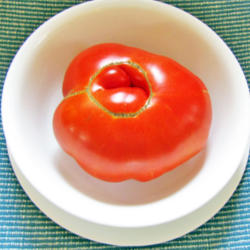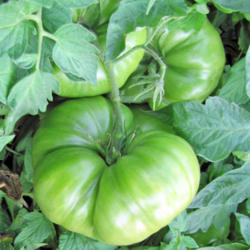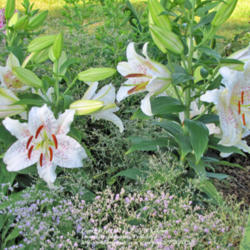| [ American Hazelnut (Corylus americana) | Posted on October 14, 2014 ] The American Hazelnut is a North American deciduous shrub that produces edible nuts. It is classified as Corylus americana and is part of the Betulaceae (birch) family. In addition to the hazelnuts, this family includes birch and alder trees. There are other trees and shrubs in this family too. Common names may include American hazelnut, bush hazelnut, American filbert or American hazel. It can be found in USDA zones 4 through 9 ranging roughly from eastern Canada and the United States southward to Florida; then westward toward Louisiana then northward to Minnesota. These plants when mature can vary from three 3 to 18 feet in height, and as much as 8 to12 feet across. |
| [ Drummond's maple (Acer rubrum var. drummondii) | Posted on October 12, 2014 ] I found this tree earlier in late summer growing in a swamp with about two feet of water around the trunk. During an outing today, I was surprised at the vivid scarlet color of the leaves. Conditions were breezy, and very bright sunlight made the leaves seem more intense. Having spent the afternoon doing research, I found that this tree is recognized by the U.S. Forest Service as the most common variety of tree in America. It is reported to be found essentially in the eastern third of the U.S. and Canada, ranging from Manitoba & Minnesota eastward to Newfoundland and then south to Florida. From there, it is found westward into Louisiana and Texas. |
| [ Apple (Malus domestica 'Crispin') | Posted on October 8, 2014 ] This apple was unknown to me three years ago when I discovered it at a local orchard under the name 'Mutsu'. The green color sometimes fades to yellow, and is similar to Granny Smith, but the taste for me is nicely crisp and pleasantly sweet. It is a firm apple and keeps its juicy texture well into winter with proper cold storage. It is equally good for making applesauce, pies, and other baked dishes, but my choice is to eat them right off the tree! It was introduced in 1948 in Japan from a cross between Golden Delicious and a sweet Japanese apple called Indo. Reportedly this was from the Mutsu Province in that country. It is known here as 'Mutsu', and is labeled with that name in our two local orchards. It is also known as Crispin in other places. |
| [ Tomato (Solanum lycopersicum 'Beefmaster') | Posted on August 27, 2014 ] This is my first year growing Beefmaster tomatoes. I am skeptical of pictures and verbal claims from some seed catalogs, so I rely on what the "real" critics have to say. Those "real" critics and analysts can be found here posting comments in the ATP Database. These comments reflect actual growing experiences with the cultivars. I am no different: I like these big, meaty tomatoes because of their size and taste. They make perfect slices for BLT's. Or, I make a tomato sandwich with just mayo and bread. On the down side, they are quite large and irregular in shape, but my overall opinion is: Great tomato! 

|
| [ Impatiens walleriana Super Elfin™ Cherry Splash | Posted on August 18, 2014 ] These plants are grown here as summer annuals. They are very sensitive to cold, freezing weather and are among the first to succumb to autumn frosts. With this said, they are among the best annuals for color and non-stop summer blooms. They are a great asset for home gardeners and landscapers. |
| [ Cucumbers (Cucumis sativus) | Posted on July 31, 2014 ] I always like planting four or five varieties of cucumbers for summer use. This year I chose Straight Eight, Early Fortune, Muncher, and Homemade Pickles. Two or three hills of each produce more than we can possibly use, so we share them with neighbors. We also donate many to a local food charity in this county. Extra rainfall in June gave us lush, healthy vines with plenty of fruits. |
| [ Daylily (Hemerocallis 'Silver Pink') | Posted on July 28, 2014 ] This came directly from Gilbert Wild Nursery back in the Mid-1990's. It has survived several transplants as well as total shade, hot sun, and soggy soil conditions. Although not showy or "glitzy," it has a quaint charm about it that is appealing when viewed along a shady path in the garden. We've grown it approximately 16-18 years: It is a very rugged plant. |
| [ Onion (Allium cepa 'Walla Walla Sweet') | Posted on July 27, 2014 ] This is our favorite onion. It is exceptionally sweet, and it goes well on cold sandwiches, such as roast beef with mayo, or sliced roast chicken breast and mayo. There is nothing better to add crisp taste to summer salads. They do not store well, and therefore we use them straight from the garden. That is not a problem here because they are in high demand for the table. |
| [ Cucumber (Cucumis sativus 'Early Fortune') | Posted on July 27, 2014 ] This is my first year for this cultivar. I prefer Straight Eight, which is earlier, and the taste and texture is equally good. With this said, it is still a good variety. |
| [ Tall Bearded Iris (Iris 'Holy Night') | Posted on June 7, 2014 ] The tall bearded iris Holy Night originated from the hybridizer, K. Mohr (Mohr Gardens) and was registered in 1983. Its color is described as a deep violet purple with a deep purple beard. No picture I have ever taken can show or do justice to its true velvety beauty. It stands out in the garden as if made from an expensive velvet fabric; and its color is enhanced by full sunlight as well as shade. What is most important is the hardiness and reliability of its growth and bloom habits. |
| [ Rose (Rosa 'General Kleber') | Posted on April 27, 2014 ] This is an old antique rose that I no longer grow because of space requirements. It is classified as a moss rose because of the appendages on the outside of the flower buds, which somewhat resemble moss growth on the north side of trees. It is said to have originated in France in 1856 and is named for Jean-Baptiste Kléber, a French general who died in Egypt in 1800. It is a light pink, lilac pastel shade with a strong fragrance. Average diameter is about 4". It only blooms once a year, in spring to early summer. |
| [ Tomato (Solanum lycopersicum 'Celebrity') | Posted on March 4, 2014 ] This is a garden favorite at our house. They are medium to large size, and they make nice meaty slices for BLT sandwiches. |
| [ Chrysanthemum 'Starlight' | Posted on December 7, 2013 ] If you like late summer and fall color in your gardens, mums are a good choice. 'Starlight' is a good all around plant and is almost maintenance free. A single 3-4 Inch potted plant will easily mature into a nice sized clump in the first summer with loads of flowers. White petals surround a soft yellow center making the effect very pleasing. I've grown the same clump in my gardens for at least 15 years with plenty of starts to give away and transplant. |
| [ Lily (Lilium auratum var. platyphyllum) | Posted on December 5, 2013 ] This is an enormous bloom with a unique combination of characteristics. First, its size is almost 10 inches across. Although outward facing, their weight seems to make them want to bow to a downward position. The colors are very appealing, with golden yellow bands flowing down each petal and sepal center. The burgundy freckles complete the picture. |
| [ Meserve Holly (Ilex 'Blue Girl') | Posted on November 22, 2013 ] These plants make good accent shrubs. Both male and female plants are required for pollination resulting in an adequate crop of berries. My problem here is that our large population of winter birds rarely leave many of the showy fruits for Christmas decoration. From what I've learned this cultivar suffers winter burn or die-out beyond USDA Zones 5a/5b. |
| [ Winterberry (Ilex verticillata) | Posted on November 22, 2013 ] These bright berries are abundant in low lying boggy/swampy areas locally. I only recently learned these existed in our county. They are plentiful in September and October; and it appears birds and other small wildlife feed on them. |
| [ Sea Lavender (Limonium platyphyllum) | Posted on November 9, 2013 ] This is a tough, winter hardy perennial. The color is a soft lavender shade, and the tiny flowers are borne on wire-like, thin stems much like Baby's Breath. My wife uses it through September in floral arrangements, especially with roses, phlox, lilies and other late blooming plants. If left undisturbed they have been known to self-sew, but are not otherwise invasive. It makes a good companion plant among Oriental lilies that bloom at the same time and do not grow too high such as Muscadet shown in this picture. 
|
| [ White Dusky Cranesbill (Geranium phaeum 'Album') | Posted on October 4, 2013 ] Alba is the Latin word from the ancient Roman period meaning 'white'. It is an adjective describing the color or appearance of a noun or other word. |
| [ Apple (Malus domestica 'Red Rome') | Posted on October 2, 2013 ] Red Rome apples are an old variety going back to about 1820 from Ohio. It was allegedly named 'Rome Beauty' in 1832, but is also known now as Red Rome and Rome. Stark Brothers Nursery has patented their version as Starkspur® Red Rome Beauty Apple. I have the Stark hybrid in a semi-dwarf tree which exceeds 15 feet in height and about the same distance in spread. |
| [ Tall Bearded Iris (Iris 'Black Suited') | Posted on September 15, 2013 ] One of the best black irises available! It not only has a great dark color, but also grows, blooms, and increases well in spite of severe winters. It also endures blistering heat and humidity here in the summer months. Definitely a winner! |